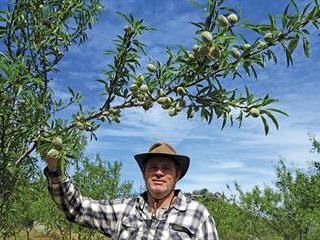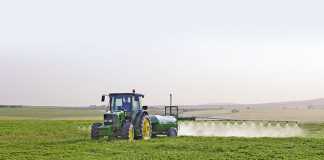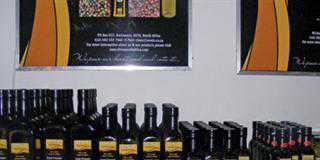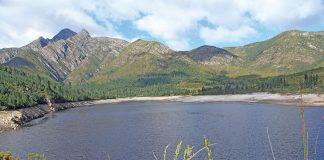
“Everything starts with the soil,” says organic almond grower Jeremy Bryant, who farms in Piket Bo-berg in the Western Cape. “We don’t farm almond trees, we farm soil, and that’s what we’ve been doing for the past 14 years.”
Soil can fend off disease just as humans can, he explains.
“When the soil is balanced and contains the correct micro-organisms and soil life, it will naturally provide the necessary protection from disease-causing organisms to the tree. Then no pesticide is necessary.”
Jeremy has 700 almond trees and 100 pecan trees on his farm Kruistementvlei. Although he admits that the start-up costs for organic farming are higher, he says that maintenance costs tail off to virtually nothing after the first few years, because a farmer can then prepare his own soil ameliorants.
“The larger the operation, the more chemicals it uses, so costs increase proportionately. Many farmers don’t question the use of chemicals; they see them as insurance against crop failure.”
‘Do-nothing farming’
Jeremy follows the principles of Masanobu Fukuoka’s ‘do-nothing farming’ philosophy. Fukuoka, a Japanese farmer, won the Asian equivalent of the Nobel Prize for his methods. He farmed for 25 years using no chemicals, yet his production was higher than that of his fellow farmers in the area who were ploughing and using fertilisers and pesticides.
‘Do-nothing farming’, also known as ‘natural farming’, means no ploughing or tilling of soil, no fertilisers, no weed control by pesticide or by hand, and no pruning of fruit trees. His system recognised and used naturally occurring living organisms in the ecosystem to farm with nature.
“Anything left over from his harvest went back onto the land,” Jeremy explains. “He didn’t add or take away from the soil. He had minimal production costs and couldn’t keep up with demand as his produce tasted better than the rest. Many minerals are required for healthy food production, but chemical companies concentrate on only nitrogen, phosphorous and potassium. Natural farming uses many more of the minerals in the soil.”
Drought-resistant tree training
Plants must be encouraged to send their roots deep down into the soil to be more water-efficient, says Jeremy.
“We limit irrigation, as excessive irrigation encourages the roots to stay close to the surface and they continually
need watering. Too much water also dilutes the quality of the crop by leaching minerals from the soil, causing it to deteriorate.”
Piket Bo-berg has sandy soil that does not retain minerals well. “We introduce organic material via the growth of what many people call weeds. Their spongy and fibrous residue binds and holds the moisture in the soil. Then the tree develops a root structure around this organic material. You want the roots to search for water.”
Jeremy irrigates his almond orchard only six to 10 times a year, using borehole water.

Fine, odourless compost from a heap, which is also used to generate hot water for the farmhouse for seven months of the year. The compost is self-aerating and watered occasionally with sprinklers.
Growing grasses
To build soil quality, Jeremy introduces organic matter and micro-organisms to the soil. “We let the grasses grow, then bend them over and cover them with a wood chip mulch to trap the life and moisture, which adds nitrogen to the soil.”
This also keeps the soil cool and moist, while reducing the competition between grasses and tree roots and increasing the amount of organic material available to micro-organisms, earthworms, wood lice and other small inhabitants of healthy soil.
“These organisms ultimately provide the plant the minerals it needs,” he explains.
All that is above the ground reflects what is below the ground, says Jeremy. Cutting or grazing grass affects root balance and this affects the remaining leaves’ ability to photosynthesise enough to feed the remaining root system adequately.
“If we cut or graze grass, too much root growth dies off, so we remove only some of it and allow the organic material to go back into the soil.”
Jeremy also maintains grasses and cover under the trees to keep the soil cool. He explains that water is absorbed into the soil only if it is cooler than the rain.
“When the soil temperature goes up, its ability to absorb moisture goes down. “Experiments have shown that grasses keep the ground cool, allowing water to penetrate better and accumulate below the normal grass root zone.”
The value of weeds
Weeds – unwanted plants in the orchard – often have extensive root systems. If the leaves are cut, their roots break down and become food for earthworms and micro-organisms. This in turn creates channels for water and air to penetrate the ground.
Jeremy explains that some weeds’ roots exude a chemical that can break through the hard pan layer in soil to reach the water and minerals deeper down. Other plants’ roots then follow these paths to the water and minerals below to survive better in drought conditions.
“The survival rate of crops with weeds is higher in drought conditions than that of crops without weeds,” he says.
Compost-powered
Jeremy and his team gather waste material from surrounding farmers to make compost. Selected materials are given to the farm’s pigs to process, and the rest is fed to their worm farm.
“This is the first link in the process of improving the soil,” he explains. ”The pig dung contains minerals and since we can’t create minerals, this is an important resource.”
The composting pig manure is used to generate hot water for the house. Water pipes are positioned in the compost mound at various levels so that cold water entering the mound causes the material to contract, and hot water causes it to expand. This continually aerates the compost without the need to turn it.
Jeremy has a wood chipper and cuts down invasive wooden alien vegetation to chip for compost, which is used on the almond trees.
“Two tons of compost has been proven to be more beneficial than 5t of manure,” he explains. “Manure is high in nitrates and contains animal pathogens and excess chemicals from the animal, including antibiotics, growth hormones and whatever else it was fed.
“Composting with natural heating is a sterilising process that breaks down chemicals and antibiotics to simpler compounds, killing any disease organisms. So compost becomes a source of life with natural flora and micro-organisms in it. Correctly finished compost and earthworm castings always has a pH of 7.”
Almond production
Jeremy’s almond and pecan trees are planted on 3ha of sandy soil. Trees are planted in winter as needed. He does no ploughing. Almond trees are planted in the traditional way in rows with compost. The soil is then covered with organic material and compost every year. Grass left to grow between the rows is mown tall. Drip irrigation is used when necessary.
No fertilisers, pesticides or other chemicals are applied. This is in contrast with conventional farmers who spend between 10% and 20% of production costs on chemicals.
The nuts are harvested in February and March. However, because fallen almonds can also be picked up on the ground under the trees, harvesting time is not that critical. Not all of Jeremy’s trees are in production yet, and he currently produces about 350kg of almonds annually. As the soil improves and young trees start bearing, production is steadily increasing.
“Organic almonds can be bought on the Internet at about R400/kg, but we sell for around R220. Demand outstrips supply, but I don’t mass produce because quality is important to me. I have annual orders placed ahead of harvest and sell at markets too.”
Pecan trees and swales
On 31 August, Jeremy planted 100 pecan trees in a modified swale system. A swale is a ditch dug along the contour and filled with organic material; it retards water runoff, prevents soil erosion and stores water for slow release into the soil.
“Our sandy soil doesn’t hold water and we have winter rain, so most of the water flows off into the river,” he explains.
Each pecan tree was placed in a 20l plastic paint bucket with its bottom removed. Holes were dug on the ridge and the soil removed to create the swales.
The buckets were then filled with vermicompost into which the tree was planted. The edge of each bucket was then lifted about three quarters of the way out of the soil, leaving only about 10cm buried, to form an elevated protective circular ‘wall’ above soil level around the young tree to prevent dassies from ring-barking it.
Every pecan tree then had four buckets of mature compost and four buckets of Eucalyptus mulch added on top of the compost to maintain its moisture content. Lastly, stones were stacked around the trunk of each tree as a heat sink, warmed by the sun in winter to prevent frost damage, and shaded by the leaves in summer to stay cool. Dew and mist condensing on the stones supply additional moisture.
Hügelkultur: hills of fertility
The German word Hügelkultur means ‘hill culture’. The concept is used in a composting process in which trees are planted on raised beds of compost and wood litter to improve soil fertility and water retention. It also warms the soil to promote optimal natural plant growth. Hügelkultur mimics the natural decomposition process on the forest floor and is ideal for poor soil areas. It is widely promoted in permaculture.
Mounds are constructed by piling logs, branches, plant waste, compost and additional soil directly onto the ground. A mound may also be made from alternating layers of wood, sod, compost, straw and soil. Although construction is straightforward, good planning is necessary to avoid creating steep slopes susceptible to erosion. Some designs recommend that mounds have a very steep gradient, but Jeremy prefers one of 30° to 45°.
“All organic matter is valuable. I collect all I can and cover waste wood with sand to start decomposing and generate a little heat to stop the ground from freezing in winter. As it breaks down, it liberates minerals without waste or creating carbon dioxide or methane and stores thousands of litres more water on the farm.”
Herbs instead of insecticides
Jeremy plants aromatic herbs, including rosemary lavender, fennel, rose geranium and African wormwood (Artemisia afra), which act as a decoy to mask fruit scent, and keeps pests at bay without using pesticides.
“I would rather do things slowly than compromise,” he says. “I’m not spending anything on chemicals, pesticides or fertiliser. I spend money on rock phosphate, mulching and manure.
I don’t think farmers are getting the right advice on how to go organic. I’m glad I am self-taught, so I haven’t been told only what chemical companies want me to know.
“We choose to farm with nature, because nature knows best. Everything works in nature. What is applied on a small scale here can be applied on a large scale too.”
Email Jeremy Bryant at [email protected].













